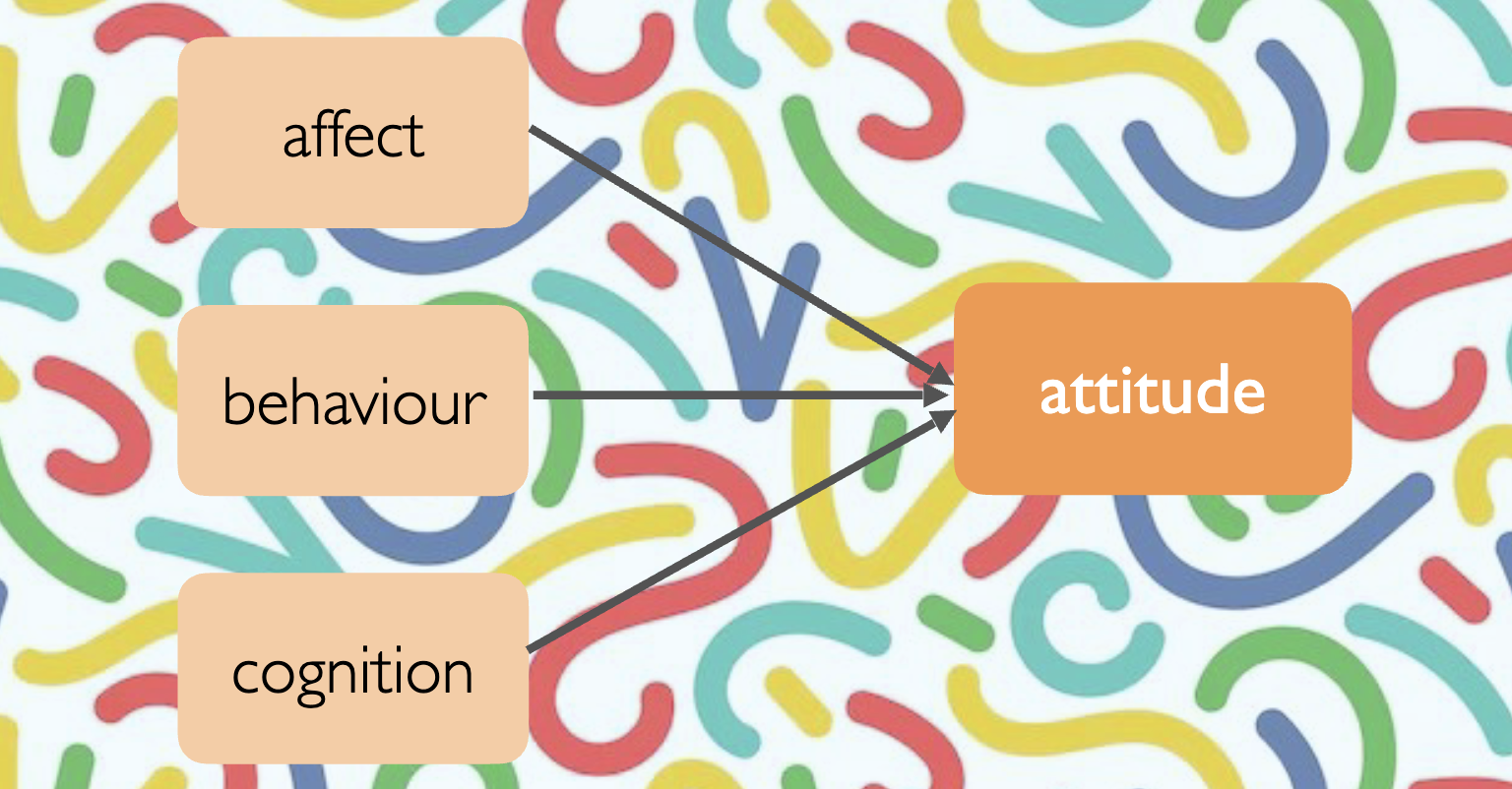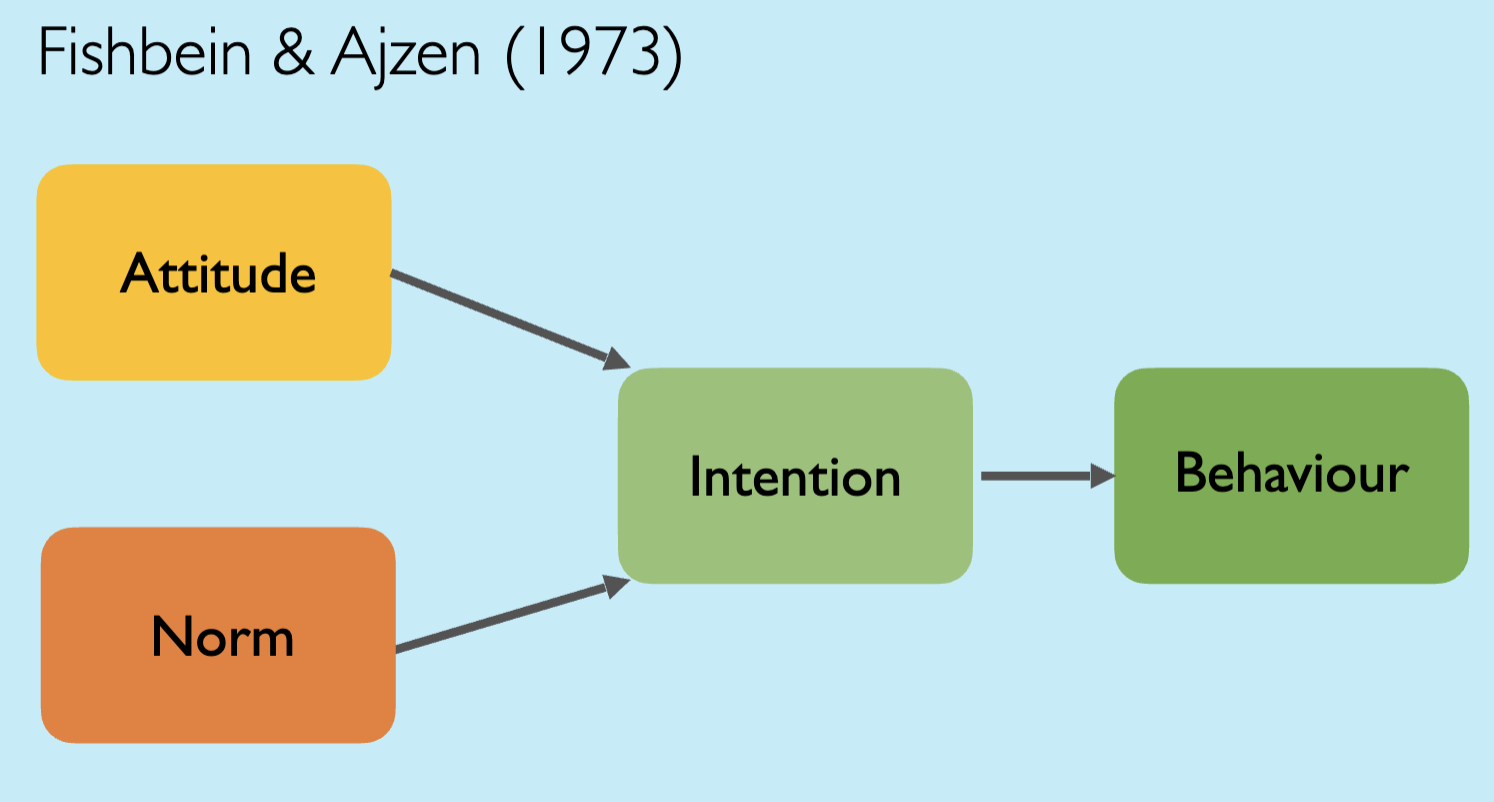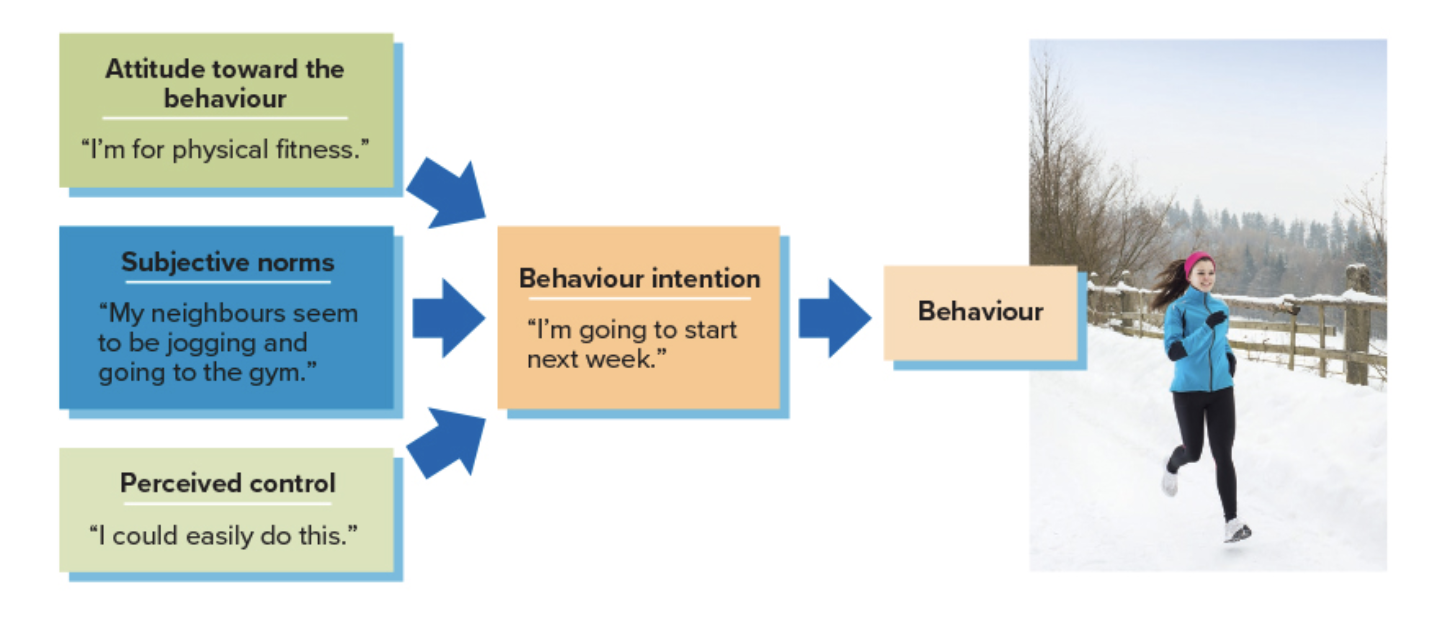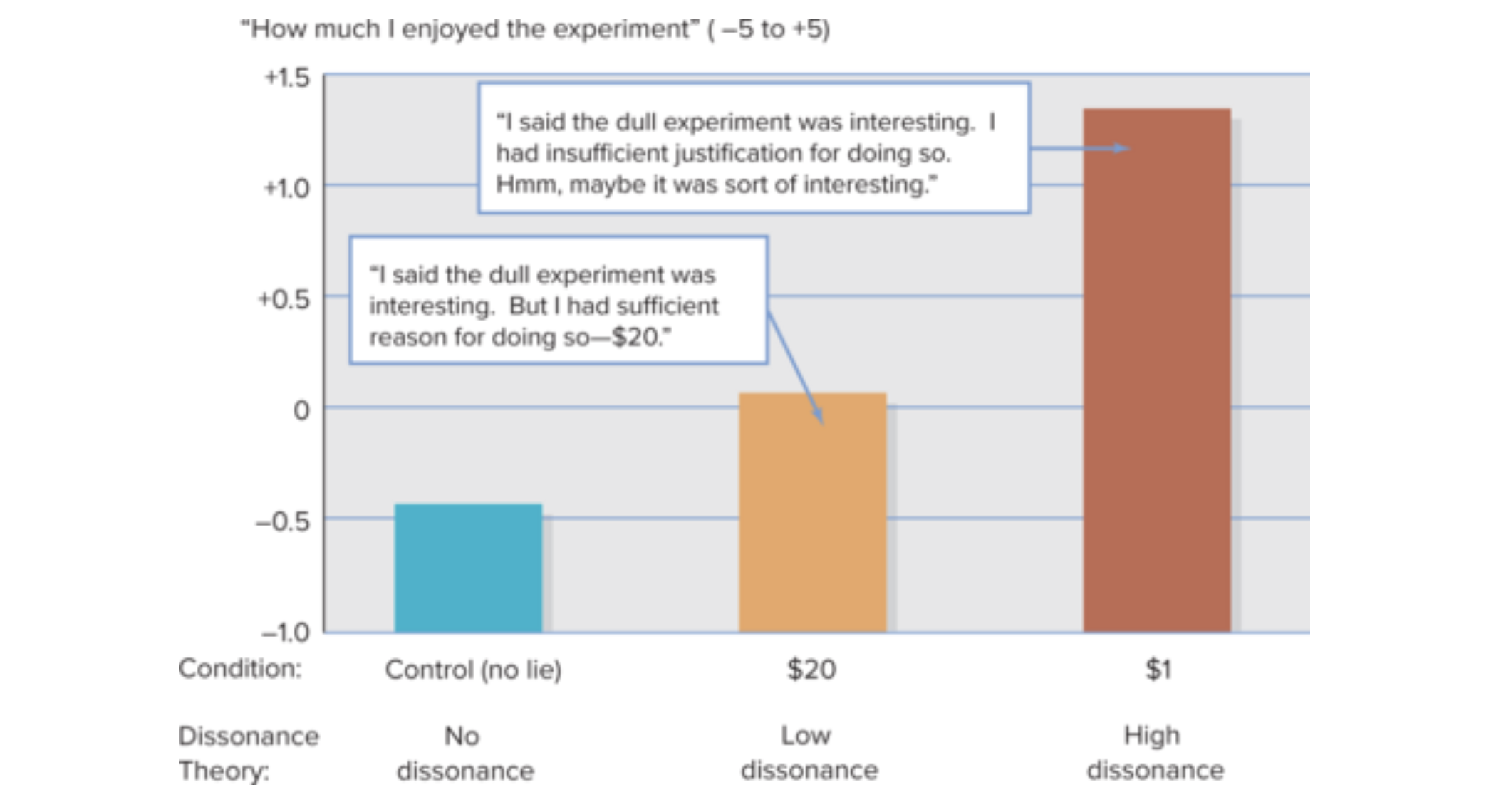Lecture 4 - Behaviour and Attitudes
1/41
There's no tags or description
Looks like no tags are added yet.
Name | Mastery | Learn | Test | Matching | Spaced |
|---|
No study sessions yet.
42 Terms
Define attitudes.
A favourable or unfavourable reaction towards something or someone, shown through one’s beliefs, feelings or intended behaviour.
What does the tripartite model of attitudes show us?
It shows us what affects our attitudes.
What does the tripartite model of attitude consist of?
affect (what we feel)
behaviour (what we do)
cognition (what we think)
*though we do need to take into account that context is also key in shaping our attitudes

Can attitudes be observed directly? Why?
No, because we all perceive things differently.
What are the measures for attitude?
implicit (ie. heart rate)
explicit (ie. survey, direct questions)
Define explicit attitudes.
Conscious beliefs that people can easily report.
Define implicit attitudes.
Automatic, unconscious ideas that influence our behaviour without our awareness.
Out of implicit and explicit attitudes, which one is the most 'important?’
Implicit attitudes.
What is the implicit association test (IAT)?
It uses reaction times in order to measure how quickly people associate concepts together. Thereby, uncovering one’s unconscious attitudes.
Define the principle of aggregation.
The sum of a set of multiple measurements is a more stable and representative estimator than any single measurement.
What are the 2 factors that intention is influenced by?
attitudes + subjective norms
Explain the theory of reasoned action.
Fishbein and Ajzen (1973).
They found that an individuals intention is determinant of their behaviour.
Hence, they argued that our attitudes and subjective norms shaped our intentions which then motivated us to exhibit a certain behaviour.

Define subjective norms.
Social norms that a person thinks is apparent in society, but is not necessarily what is apparent in society.
Why is the theory of reasoned action an explicit measurement?
Because survey’s and questionnaires are used to directly ask people about their attitudes, subjective norms, and behavioral intentions regarding a specific behaviour.
Explain the theory of planned behaviour.
When your attitudes, subjective norms and sense of control shape your intention and thus whether you carry out that behaviour our not.

Is Azjen’s theory of planned behaviour so straight-forward?
No!
Sometimes there are things that are more important to us that can cause us to behave a certain way (ie. going to a doctors appointment vs. baking muffins)
sometimes we have spontaneous behaviours
sometimes we have the intention but ultimately, we get lazy or tired
When do our attitudes predict our behaviours?
When we can review our past actions
hence, we can see that we have done it before, making us more likely to do it again (ie. I used to recycle diligently in my old house, so now I can do it now)
High self-awareness
when we have higher self-awareness we can remember what is important to us/what we stand for which can be a good motivator for us to do things
Attitude formed through experience
when we form attitudes from our experiences we are more likely to behave accordingly because we have been moved/our mindsets have altered now
When does our behaviour shape our attitudes?
when we are unsure about how we feel about a situation and so how we behave will tell us how we feel (our attitude) about the situation
when there are minimal things to influence our behaviour
Why does not knowing how we feel about a situation shape our attitudes?
If we don’t know how we feel about a situation, how we behave will be an indicator of how we feel (our attitude) about the situation.
Define role playing.
Actions expected of those who occupy a particular social position (ie. teacher, student, firemen, daughter, mother).
What is an example of the powers of role playing?
Stanford Prison Experiment (Zimbardo 1972)
Zimbardo simulated a prison in the basement of the university he was working at at the time. Some students acted as prison guards and others as prisoners.
This was a planned 2 week study but it ended after only 6 days! This is because the students went into character too well and the ‘prison guards’ were becoming abusive to the ‘prisoners’ (aka. their fellow peers).
What did the Stanford Prison Experiment reveal?
our roles can shape our attitudes (because the ‘prison guards’ started to think that they really were superior to the ‘prisoners’ when they played that role — shaping their attitudes)
the impact of a social situation on our roles (because good people started to act like bad people when put in a bad environment)
Define the foot in the door phenomenon.
The tendency for people agree to small request and then comply to a larger request later.
Define the low ball technique.
The exploitation of people’s initial agreement/commitment to a small request by changing the terms into something larger.
What’s the difference between the foot in the door phenomenon and low ball technique?
The "foot-in-the-door" technique involves getting someone to agree to a small, initial request to make them more likely to agree to a larger, related request later.
However, the "low-ball" technique involves securing commitment to an attractive offer, only to reveal less favourable terms afterward, exploiting the person's commitment to the initial agreement.
The key difference is that the foot-in-the-door requires completing the first small task before the larger one, whereas the low-ball technique changes the terms of a single commitment before any action.
Explain the door in the face technique.
It is the tendency for people who have denied a larger request to later agree to a smaller request. This happens through the ‘request by moderation’ procedure.
What are the 3 reasons our behaviours influence our attitudes?
Self-presentation
Self-justification
Self-perception
Explain self-presentation.
This concept is about maintaining a good impression in order to:
gain social/material rewards
feel better about ourselves
feel more secure in who we are
appear consistent to others
Why does self-presentation lead our behaviours to shape our attitudes?
Because the behaviours we use to shape the impressions we give off can lead us to internally change our attitudes about a situation.
In what ways do we self-justify things?
Through:
selective exposure - when we prefer to only expose ourselves to info that aligns with our point of view
cognitive dissonance - defined later
Define cognitive dissonance.
The uncomfortability we feel when we have two conflicting thoughts and when our behaviour does not match with our attitudes.
How does self-justification lead our behaviours to shape our attitudes?
By justifying our past behaviours we change/reinforce our attitudes to align with the action rather than our original attitude.
This is so we can reduce any cognitive dissonance.
By doing this we are allowing our behaviours to shape our attitudes.
Dissonance theory.
The idea that when an individuals actions are not justifiable by receiving external rewards or coercion, they experience cognitive dissonance.
Hence, the only way to reduce that dissonance is to start believing in what they’re doing.
What was the experiment of dissonance theory? What was the conclusion?
Festinger and Carlsmith (1959)
Participants spent an hour doing boring tasks (turning knobs)
Then they were asked to tell the next “participant” (actually an assistant) that the activity was fu
Some were paid $1 for this lie, others $20
Lastly, the participants had to rate how much they actually enjoyed the tasks
Those paid only $1 reported greater enjoyment because they had very little external justification for lying. Hence, they experienced cognitive dissonance and felt a greater need to resolve the tension created by lying and thus changed their attitudes to align with their actions.
In contrast, those paid $20 had enough justification and felt less cognitive dissonance and did not need to adjust their beliefs.

What is the cognitive dissonance process?
We have to choose between equally attractive (or unattractive) options
The undesirable features of the thing we chose and desirable features of the thing we rejected stay on our mind after picking
Cognitive dissonance is then created
To manage this dissonance we have to boost up our choice and try to downplay the thing we rejected
Explain the self-perception theory.
It suggests that we make similar inferences about ourself to that of others who can only observe our behaviour (and not the inner-workings of our minds).
Why do we make similar inferences about ourselves that other people might make about us in the self-perception theory?
This occurs when our attitudes are weak and ambiguous. Therefore, putting us in a similar position of those who are observing us from the outside (since we have no inner-thoughts about the situation and so we, and others, see the same thing).
How does self-perception theory lead our behaviours to shape our attitudes?
Our perception of ourself when our attitudes are unclear still can lead us to behave in a certain way. Therefore, our behaviour becomes the indicator we use in order to know what our attitude about a certain situation is.
Define the over-justification effect.
This is when individuals do something they enjoy, without a reward or coercion, and so they automatically attribute their behaviour to the fact that they ‘LOVE’ that activity.
What does the over-justification effect show about the relationship between rewards and motivation?
It shows how external rewards can reduce peoples’ intrinsic motivation to do something because it feels like they are only doing something for the incentive vs. the fact that they really do wanna do it. Therefore, creating greater dissonance.
What’s intrinsic motivation.
When people do something because they really wanna do it.
Define extrinsic motivation.
When people do something because there is an incentive involved, but not of their own volition.